Research Data Management and Publishing
Open Access to publications
In most general terms, Open Access means that research articles are accessible on the Internet to everyone free of charge.
A more specific definition also stresses that besides reading the articles free of charge, the full Open Access also allows text mining, i.e., the articles are provided with relevant unambiguous licences.
Thus, Open Access refers to research articles which are accessible on the Internet free of charge and which are provided with a licence allowing text mining.
The requirement for Open Access was a pioneering idea in the world of Open Science. It was felt that research results, published with taxpayers’ money, should be accessible to all and people should not pay the second time to be able to read them. Currently, taxpayers commission research from researchers (grant funding) and then have to pay for reading the results of those research (subscription to research journals). In many countries around the world, it is impossible to subscribe to scientific journals due to lack of money.
The Open Access movement was started in Budapest in 2002; it is today known as the Budapest Open Access Initiative.
This document defines Open Access as follows:
By “open access” we mean its free availability on the public internet, permitting any users to read, download, copy, distribute, print, search, or link to the full texts of these articles, crawl them for indexing, pass them as data to software, or use them for any other lawful purpose, without financial, legal, or technical barriers other than those inseparable from gaining access to the internet itself. The only constraint on reproduction and distribution, and the only role for copyright in this domain, should be to give authors control over the integrity of their work and the right to be properly acknowledged and cited.
The document set the objective that peer-reviewed articles should be accessible in two ways:
- self-archiving in a repository
- publishing in an Open Access journal
Providing open access to scientific articles is fair and supports researchers worldwide in solving global problems. The example below illustrates the fact that many scientific institutes do not have access to modern results in ophthalmology because they do not have the money to subscribe to scientific journals.
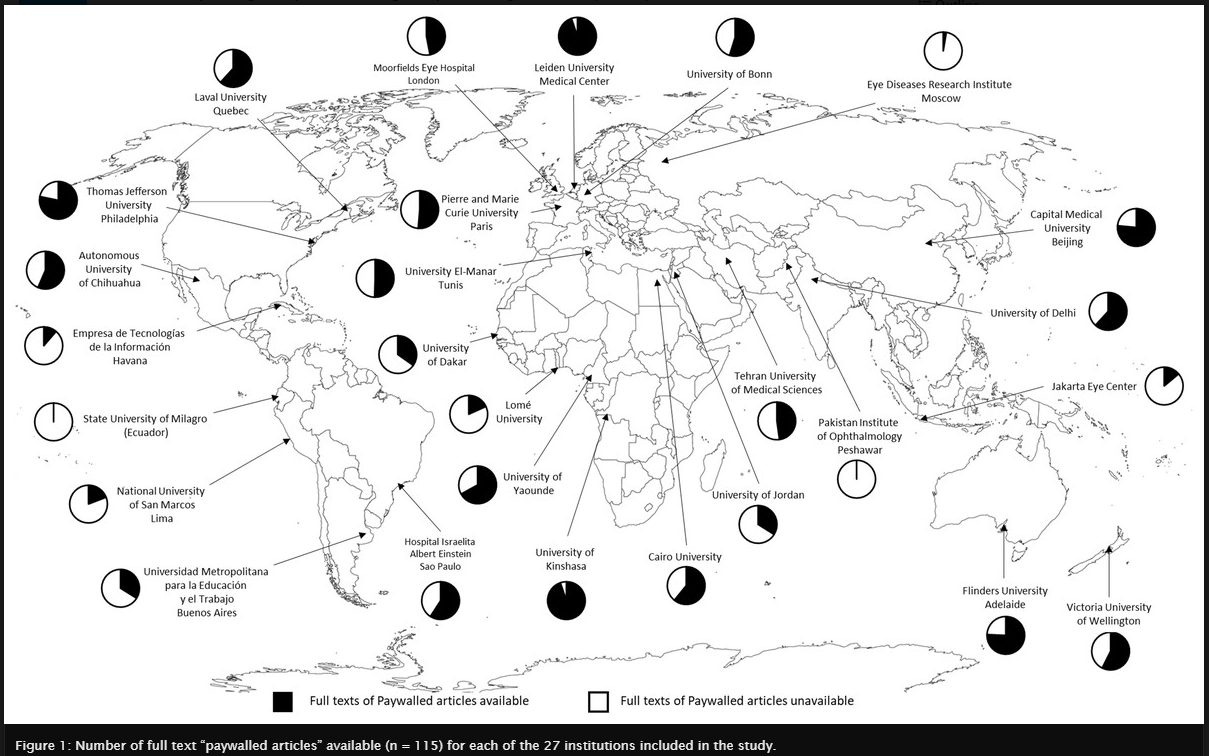 Boudry C, et al., 2019. Worldwide inequality in access to full text scientific articles: the example of ophthalmology. PeerJ 7:e7850 https://doi.org/10.7717/peerj.7850
Boudry C, et al., 2019. Worldwide inequality in access to full text scientific articles: the example of ophthalmology. PeerJ 7:e7850 https://doi.org/10.7717/peerj.7850
Three paths of Open Access
Three main paths can be distinguished in Open Access publishing:
Green Open Access or self-archiving: the author archives the article, which has been published in a research journal, in some disciplinary or institutional repository, thus making it accessible to all. The author does not pay any publishing fee, but the journal may require an embargo period, i.e., the article may not be freely accessible right after its publishing.
Gold Open Access: the article is published in a journal for a fee (APC – Article Processing Charge) and is immediately made accessible to readers. Journals with such business model consider themselves Open Access journals and they must be registered at the portal Directory of Open Access Journals (DOAJ). Publishing costs should be covered by grants, applied for at specialised academic associations or some other funders.
Hybrid Open Access: immediate open access to articles in subscription journals. To get it, the researcher has to pay the APC. From the researcher’s point of view, this is the most disadvantageous business model, since the subscription for a journal has to be paid anyway (subscribed and paid for by the library, following the researchers’ recommendations), but the researchers have to pay the additional publication fee.
The article processing charge is quite large, in average about 2000-3000 euros per article. For example, see the APC of the journal Nature.
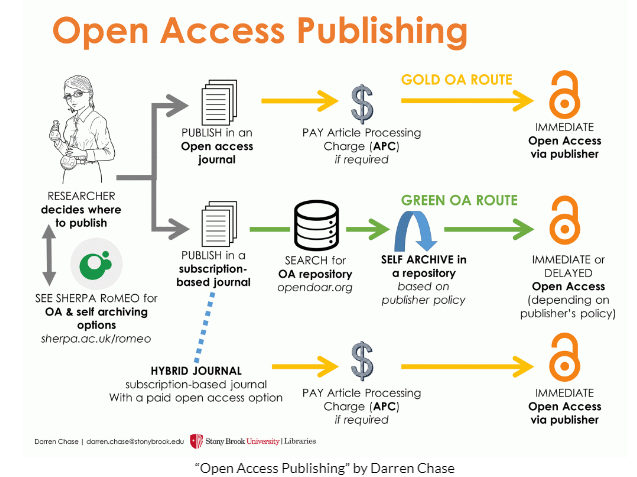
When thinking about Open Access publishing, the authors should check the database SHERPA/RoMEO .
This database contains information about more than 22 000 peer-reviewed journals, about their Open Access policies, possibilities for self-archiving, licencing conditions, etc.
As the landscape of Open Access journals is exceptionally varied and each day brings forward new titles, it is essential to avoid publishing in predatory journals. Here, the web page Think.Check.Submit, which is backed by well-acknowledged organisations, is the author’s best tool and helper.

Authors can also find help on the web page AuthorAid.
Additional reading: Shen, C. and Shah, L., 2023. Predatory publishing practices: what researchers should know before submitting their manuscript. Insights: the UKSG journal, 36(1), p.19. DOI: https://doi.org/10.1629/uksg.631
In addition to the types of Open Access mentioned above, there is the concept of Bronze Open Access: the article is made OA by the publisher, but it is not licenced, meaning that it can be freely read, but text mining is not allowed.
Researchers are probably most interested in the statistics about how often are open access articles cited in comparison with articles published in subscription journals.
Several surveys have been carried out to find an answer to this question; here are the results concerning the following OA article:
Piwowar H, Priem J, Larivière V, Alperin JP, Matthias L, Norlander B, Farley A, West J, Haustein S. (2018) The state of OA: a large-scale analysis of the prevalence and impact of Open Access articles. PeerJ 6:e4375 https://doi.org/10.7717/peerj.4375
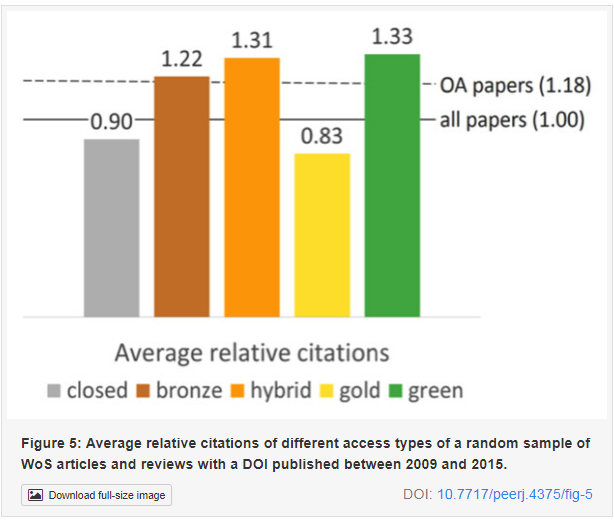
It is interesting to compare the OA types used by larger and better known publishers and their proportions:
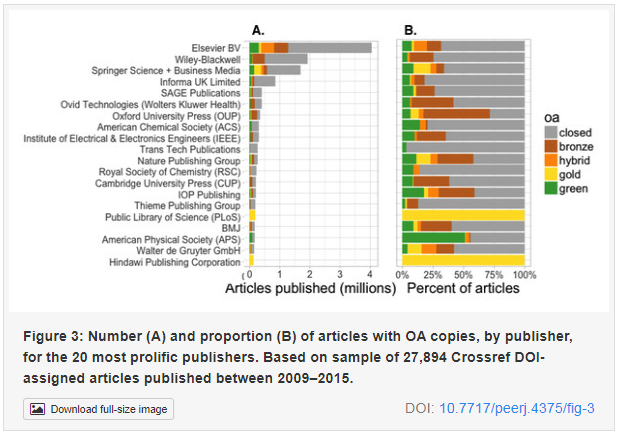
The subject areas where researchers publish OA articles:
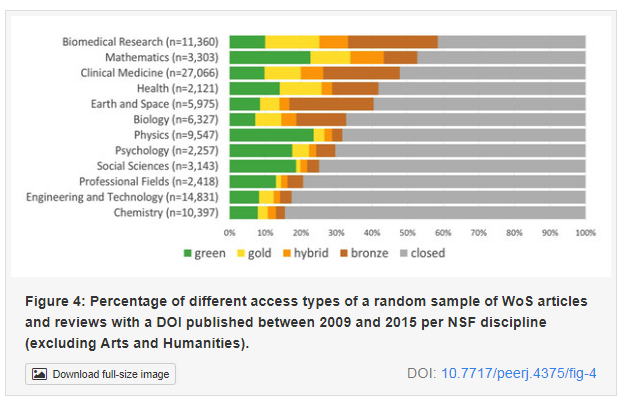
Journal of biomedicine, showing the publisher’s point of view:
Preprindid
There is still another legal possibility for making your article accessible via Open Access and at the same time, to publish it in a journal of high impact factor – this is archiving it in an archive of preprints.
Sherpa_ROMEO defines preprint as a draft of an article, its first version, which has not yet been submitted for reviewing to a journal; the notion of preprint also includes conference papers and reports.
For example, the Elsevier web page clearly states that publishing preprints before publishing the actual article is allowed:
Multiple, redundant or concurrent publication: An author should not in general publish manuscripts describing essentially the same research in more than one journal or primary publication. Elsevier does not view the following uses of a work as prior publication: publication in the form of an abstract; publication as an academic thesis; publication as an electronic preprint.
The policies of many other academic publishers regarding preprints can be found on Wikipedia:
Publishing your article as a preprint can be useful for several reasons:
- Open Access articles receive more citations, because they are accessible to all. When publishing the same article in an academic journal, the publisher may set an embargo period and in this case, other researchers can use it only after six months.
- Publishing of a preprint is free of charge – there is no APC.
- Preprint can immediately receive a DOI and a time stamp, which are essential in ensuring its findability and citability and support the author in academic competition.
- Other researchers may notice some mistakes or shortcomings, which should be corrected or explained before submitting the text to a journal.
- Conference papers will be searchable.
- Preprints are indexed by Google Scholar and Altmetrics.
For example, the Wellcome Trust, which funds medical research, revealed its new policy in November 2018, stating that in such cases where research results could bring considerable benefit to public health, the results have to be immediately published as a preprint.
Publishing of preprints is subject to all norms of research ethics and customary requirements for research articles. Generally, an already published preprint cannot be extracted from the archive.
A preprint in arXive Is preprint the future of science? A thirty year journey of online preprint services (2021) states that number of preprints has exponentially increased 63 times in 30 years, although it only accounts for 4% of research articles. Second, we quantify the benefits that preprints bring to authors: preprints reach an audience 14 months earlier on average and associate with five times more citations compared with a non-preprint counterpart. Last, to address the quality concern of preprints, we discover that 41% of preprints are ultimately published at a peer-reviewed destination, and the published venues are as influential as papers without a preprint version.
Some preprint archives:
- arXiv: physics, mathematics, computer science, statistics, quantitative biology (1,5 mill.)
- bioRxiv: biology (30 thousand)
- MarXiv: marine biology and marine climate
- psyArXiv: psychology, psychiatry, neurosciences
- SocArXiv: social sciences
- preprints.org: multidisciplinary
Open Science Framework has a preprint portal, allowing complex search and showing the existing subject archives of preprints.
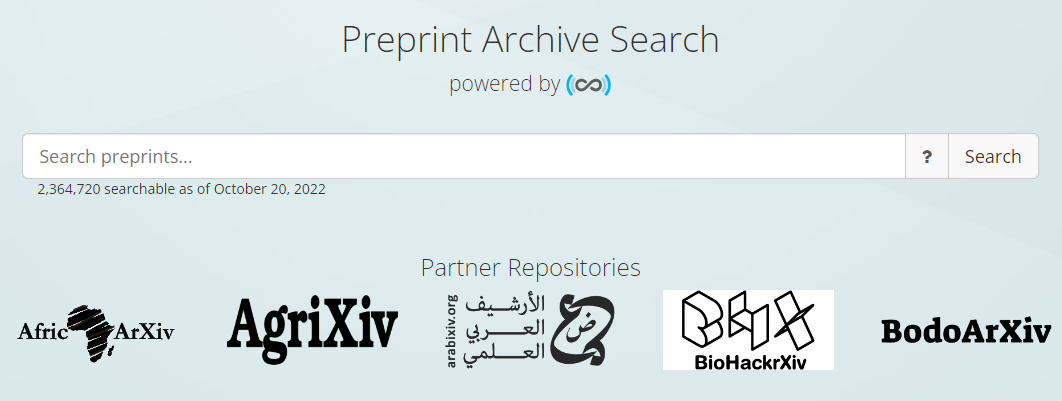
In case one has a practical need to publish a preprint, you can find the published guidelines:
Kristina Hettne, Ron Aardening, Dirk van Gorp, Chantal Hukkelhoven, Nicole Loorbach, Jeroen Sondervan, & Astrid van Wesenbeeck. (2021). A Practical Guide to Preprints: Accelerating Scholarly Communication (1.0). Zenodo. https://doi.org/10.5281/zenodo.5600535
ASBMB published an opinion What is better for your career than a publication? A preprint. and a graph is added, describing the increase of preprints in last years:
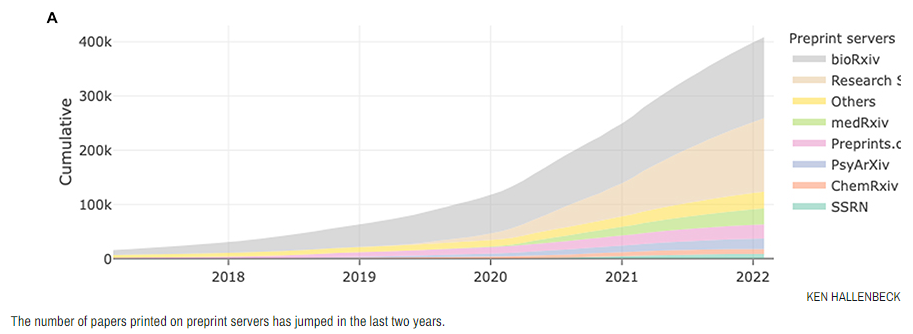
In parallel with the increasing number of published preprints, there is a discussion underway about peer reviev of preprints that is supposed to be more quick, collegial and transparent than traditional peer review.
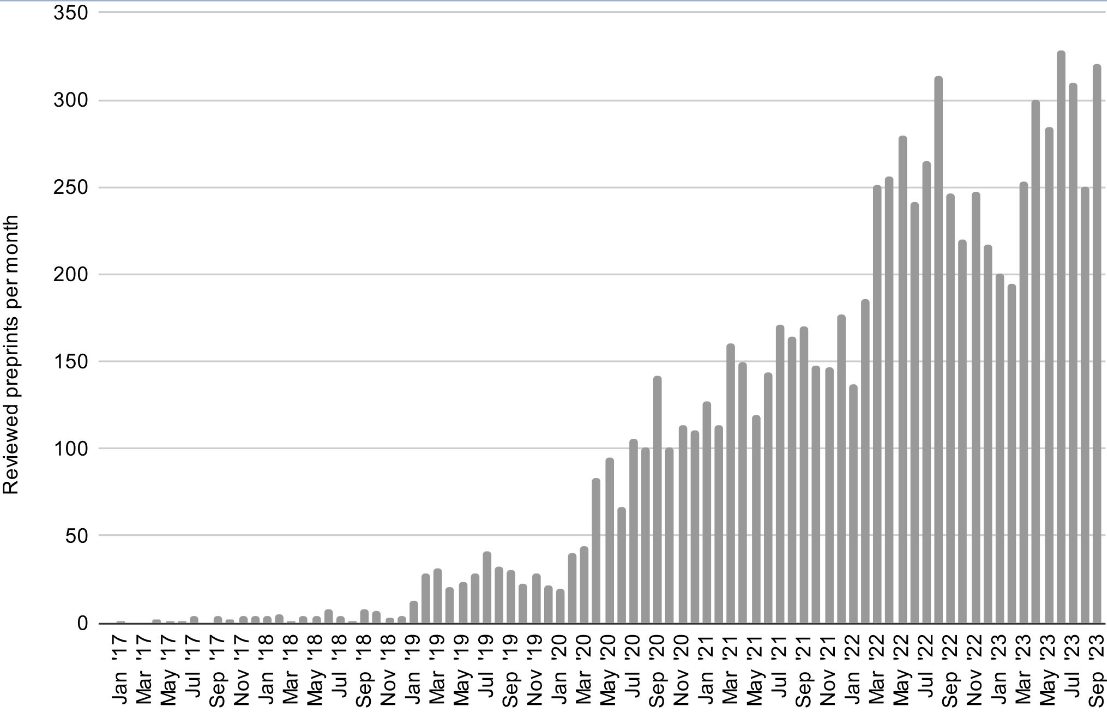
Resource: Avissar-Whiting M, Belliard F, Bertozzi SM, Brand A, Brown K, Clément-Stoneham G, et al. (2024) Recommendations for accelerating open preprint peer review to improve the culture of science. PLoS Biol 22(2): e3002502. https://doi.org/10.1371/journal.pbio.3002502
Additional reading:
10 tips for submitting a successful preprint
The effect of bioRxiv preprints on citations and altmetrics
There is a study that aims to provide a global picture of OA adoption by countries, using two indicators: publications in OA and references made to articles in OA. Weighted z-score and normalized map of the number of OA publications by country. Brown indicates that a country is above the world average, green indicates it is below the world average.
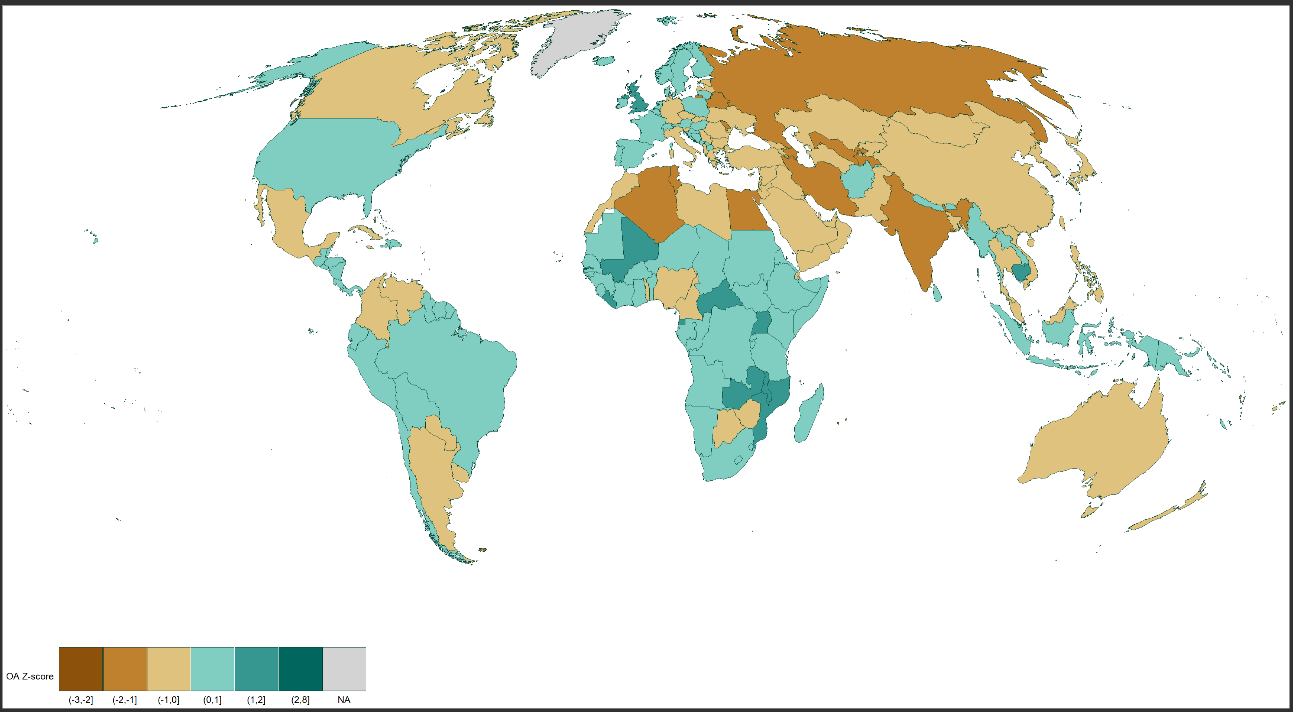
Simard M-A, Ghiasi G, Mongeon P, Larivière V (2022) National differences in dissemination and use of open access literature. PLoS ONE 17(8): e0272730. https://doi.org/10.1371/journal.pone.0272730


